25 start with H start with H

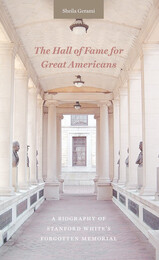
It also examines in depth what is arguably the least studied project of Stanford White, one of the most distinguished architects of the Gilded Age. Originally designed for New York University’s new campus in the Bronx, the Hall of Fame once housed ninety-eight bronze busts of men and women deemed “great Americans” within its elegant colonnade, including the likes of George Washington, Nathaniel Hawthorne, Booker T. Washington, Susan B. Anthony, and Robert E. Lee.
The Hall was conceived when the Great Man theory dominated American thought. However, as times changed, challenges to ideas concerning greatness and heroism grew, and heroes once celebrated were scrutinized for their flaws. The monument is now a shell of its former glory and largely forgotten, and the NYU campus that once housed the colonnade was eventually sold to Bronx Community College.
In 2017, following the violent demonstrations in Charlottesville, Virginia, by white supremacists attempting to prevent the removal of a monument to General Lee, Andrew Cuomo, then governor of New York, thrust the Hall of Fame back into the limelight by ordering the busts of Lee and Stonewall Jackson to be removed. This action joined a national trend to remove monuments deemed offensive. Gerami argues that the rise and fall of this institution mirrors the nation’s changing conception of what comprises a hero. This biography of a public art memorial answers questions about the importance of art history and the cultural evolution of what it means to be great in America.
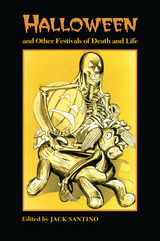
Jack Santino has put together the first collection of essays to examine the evolution of Halloween from its Celtic origins through its adaptation into modern culture. Using a wide variety of perspectives and approaches, the thirteen essayists examine customs, communities, and material culture to reveal how Halloween has manifested itself throughout all aspects of our society to become not just a marginal survivor of a dying tradition but a thriving, contemporary, post-industrial festival. Its steadily increasing popularity, despite overcommercialization and criticism, is attributed to its powerful symbolism that employs both pre-Christian images and concepts from popular culture to appeal to groups of all ages, orientations, and backgrounds. However, the essays in this volume also suggest that there is something ironic and unsettling about the immense popularity of a holiday whose main images are of death, evil, and the grotesque.
Halloween and other Festivals of Death and Life is a unique contribution that questions our concepts of religiosity and spirituality while contributing to our understanding of Halloween as a rich and diverse reflection of our society’s past, present, and future identity.
The Editor: Jack Santino is an associate professor in the department of popular culture at Bowling Green State University, Bowling Green, Ohio.

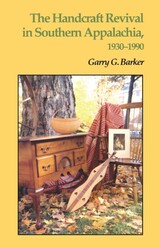
Appalachians have always honored craft. Showoff quilts, complicated whittlings, "face jugs," intricate woven coverlets, and the work of famous basketmakers constituted the art of early Appalachia, the life and color of its remote mountain households. By the 1920s, however, the craft tradition was quickly vanishing. This lively, highly personal book recounts the "missionary" effort that preserved the traditional Appalachian craft culture and traces the organization, politics, and economics of later handcraft revival organizations in Southern Appalachia.
Deeply involved in many of the events he describes, Garry Barker has worked in the Appalachian crafts world since the early 1960s. He draws on memories of the leading craftspeople of a bygone era, LBJ's War on Poverty, mushrooming markets for craft products, and the rise of academic crafts training. The Handcraft Revival in Southern Appalachia represents the thoughtful winnowing of Barker's decades of serendipitous experience and disciplined observation, casual conversation and formal interviews, research and collecting, teaching and writing.
The book is the only history of the Appalachian craft movement between 1930 and 1990. As such it will become an essential resource for craftspeople, scholars, and all interested in the Southern Appalachian region. In addition, it constitutes a crucial chapter in the newly emerging history of American craft.
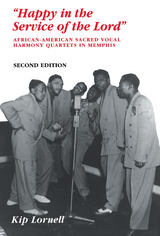
The author traces the evolution of such groups as the I. C. Glee Club Quartet, the Spirit of Memphis, the Sunset Travelers, and the Southern Wonders from the early 1920s to the late 1980s. Drawing on extensive interviews and field research, Lornell describes a unique world of radio personalities, quartet unions, fans, promoters, and singing teachers. What emerges is a fascinating picture of the complex, multilayered relationships within these communities, enhanced by a probing analysis of the gospel quartets' place within the larger contexts of popular culture and African-American history.
"Happy in the Service of the Lord" was first published in 1988. For this second edition, Lornell has added a new chapter on the role of gospel composers and the importance of spirituality in quartet performances. The first chapter, a survey of the history of quartet singing across the United States from Reconstruction to the present, has been completely rewritten to reflect the most recent scholarship. Lornell has also updated and expanded the book's audiography and bibliography.

Many of the essays touch on death and the dying, and nothing escapes description and fascination whether profound or seemingly less so: the death of a dear friend or two fledgling cardinals blown from a nest in the back yard and now covered with “periwinkle at the corner of the yard.” During a walk down a country lane, the names of flowers, birds, and bugs fill the page. Even in a meadow buzzing with life, there are reminders of our mortality and brief light too soon gone—and they remind us to read, think, and live with gusto and love.
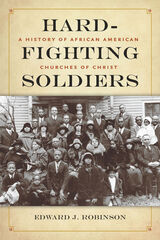
Robinson’s well-researched narrative treats not only the black male leaders of the church, but also women leaders, such as Annie C. Tuggle, as well as notable activities of the church, including music, education, and global evangelism, thus painting a complete picture of African American Churches of Christ. Through scholarship and compelling storytelling, Robinson tells the two-hundred-year tale of how “black believers survived and thrived on the discarded ‘scraps’ of America, forging their own identity, fashioning their own lofty ecclesiology and ‘hard’ theology, and creating their own papers, lectureships, liturgy, and congregations.” A groundbreaking exploration by a seasoned scholar in American religion, Hard-Fighting Soldiers is sure to become the standard text for anyone researching the African American Churches of Christ.
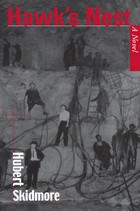
Appalachian Echoes
Thomas E. Douglass, series fiction editor
“Very real and tremendously moving. . . . Not only an obvious brief for the unfortunate but a well told and honest story.” —New York Times
“Hubert Skidmore, a native West Virginian, wrote as a witness from inside the belly of the beast. His gift is for pitch-perfect dialogue, a varied cast of characters, and the calling up of emotion, of anger, fear, dread, and love. To encounter this novel at last is a sort of resurrection, both for its persecuted author and the Depression poor whose lives it evokes.” —Denise Giardina, author of The Unquiet Earth and Storming Heaven
The building of a tunnel at Gauley Bridge, West Virginia, beginning in 1930 has been called the worst industrial disaster in American history: more died there than in the Triangle Shirtwaist Factory fire and the Sunshine and Farmington mine disasters combined. And when native West Virginian Hubert Skidmore tried to tell the real story in his 1941 novel, Union Carbide and Carbon Corporation apparently convinced publisher Doubleday, Doran & Co. to pull the book from publication after only a few hundred copies had appeared.
Now the Appalachian Echoes series makes Hawk’s Nest available to a new generation of readers. This is the riveting tale of starving men and women making their way from all over the Depression-era United States to the hope and promise of jobs and a new life. What they find in West Virginia is “tunnelitis,” or silicosis, a disease which killed at least seven hundred workers—probably many more—a large number of them African American, virtually all of them poor. Skidmore’s roman à clef provides a narrative with emotional drive, interwoven with individual stories that capture the hopes and the desperation of the Depression: the Reips who come from the farm with their pots and pans and hard-working children, the immigrants Pete and Anna, kind waitress Lessie Lee, and “hobos” Jim Martin, “Long” Legg, and Owl Jones, the last of whom, as an African American, receives the worst treatment. This important story of conscience encompasses labor history, Appalachian studies, and literary finesse.
Hubert Skidmore (1909–1946) was the author of five other novels: I Will Lift Up Mine Eyes (1936), Heaven Came So Near (1938), River Rising (1939), Hill Doctor (1950), and Hill Lawyer (1942). He died in a house fire at the age of thirty-seven.
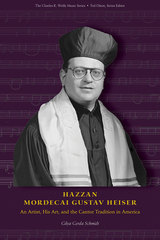
But this book is more than a memorial to Heiser. Schmidt melds decades of archival research, conservation efforts, family interviews, and trips to Jerusalem and Berlin into a critical reconstruction of the life and vision of Hazzan Mordecai Gustav Heiser in the multiple contexts that shaped him. Coming of age in Berlin in the afterglow of the Second German Empire meant that young Gustav had tasted European Jewish culture in a rare state of refinement and modernity. But by January 30, 1940, when he reached New York with his wife, Elly, and two-and-a-half-year-old daughter, Judith, Cantor Heiser had lost nearly all of his living family relations to the extermination programs of the German Reich, after narrowly surviving a brief incarceration at Sachsenhausen.
While Cantor Heiser’s art was steeped in nineteenth-century tradition, Schmidt contends that Heiser’s music was a powerful affirmation of Jewish life in the twentieth century. In a final chapter, Schmidt describes his influence on the American cantorate and American culture and society.

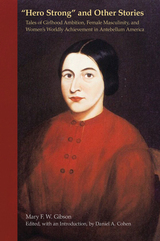
early 1850s as a star writer, under the pseudonym Winnie Woodfern, for more than half a
dozen Boston “story papers,” mass-circulation weekly periodicals that specialized in popular
fiction. Although she would soon join such famous woman authors as Fanny Fern
and E. D. E. N. Southworth as featured contributors to the New York Ledger, America’s
greatest story paper, Gibson’s subsequent output rarely matched the gender-bending creativity
of the tales written in her late teens and early twenties and reprinted in this volume.
But “Hero Strong” and Other Stories does much more than recover the work of a
forgotten literary prodigy. As explained by historian Daniel A. Cohen, Gibson’s tales
also illuminate major interrelated transformations in American girlhood and American
women’s authorship. Challenging traditional gender expectations, thousands of girls of
Gibson’s generation not only aspired to public careers as writers, artists, educators, and
even doctors but also began to experiment with new forms of “female masculinity” in
attitude, bearing, behavior, dress, and sexuality—a pattern only gradually domesticated
by the nonthreatening image of the “tomboy.” Some, such as Gibson, at once realized and
reenacted their dreams on the pages of antebellum story papers.
This first modern scholarly edition of Mary Gibson’s early fiction features ten tales of
teenage girls (seemingly much like Gibson herself) who fearlessly appropriate masculine
traits, defy contemporary gender norms, and struggle to fulfill high worldly ambitions.
In addition to several heroines who seek “fame and riches” as authors or artists,
Gibson’s unconventional protagonists include three female medical students who resort to
grave robbing and a Boston ingénue who dreams of achieving military glory in battle. By
moving beyond “literary domesticity” and embracing bold new models of women’s
authorship, artistry, and worldly achievement, Gibson and her fictional protagonists stand
as exemplars of “the first generation of American girls who imagined they could do almost
anything.”
Daniel A. Cohen is an associate professor of history at Case Western Reserve University.
His previous publications include Pillars of Salt, Monuments of Grace: New England Crime
Literature and the Origins of American Popular Culture, 1674–1860 and ‘The Female Marine’
and Related Works: Narratives of Cross-Dressing and Urban Vice in America’s Early
Republic.
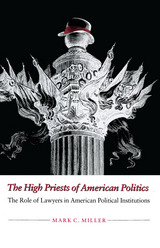
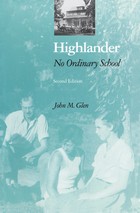
First named the Highlander Folk School and established in 1932 by Myles Horton and Don West near Monteagle, Tennessee, this adult education center has been both a vital resource for southern and Appalachian activists and a catalyst for several major movements for social change. During its first thirty years, Highlander served as a community folk school, as a training center for southern labor and Farmer's Union members, and as a meeting place for black and white civil rights workers. Its advocacy of racial equality ultimately prompted the state of Tennessee to revoke the charter of the original institution in 1962. Undaunted, the school's officers reorganized the institution as the Highlander Research and Education Center in Knoxville, where it gave ongoing support to the civil rights movement and promoted a multiracial poor people's coalition. Today, operating in New Market, Tennessee, it continues to devise new strategies of progressive change from the experiences of ordinary people.
This comprehensive history offers a unique perspective on the movements, institutions, organizations, and individuals that permanently reshaped our understanding of the South and Appalachia in the twentieth century. It also suggests the range of problems and possibilities of using education to achieve economic, political, and racial justice.
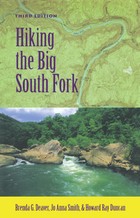
The book features detailed maps; checklists of mammals, birds, and wildflowers; and valuable advice on safety, park rules and regulations, and accommodations. The trail descriptions include difficulty ratings, distance and time information, notes on accommodations and special considerations, and detailed mileage indicators to keep hikers informed of their progress and to clarify points of confusion. Also included is a handy chart designed for backpackers who wish to combine trails for longer excursions.
Strollers, hikers, and backpackers looking for a less-crowded alternative to the Great Smoky Mountains National Park will enjoy discovering this beautiful, rugged National Park service area. Only a ninety-minute drive northwest of Knoxville, the Big South Fork National River and Recreation Area is easily reached in half a day or less from Louisville, Nashville, Chattanooga, and Atlanta.
The Authors: Brenda G. Deaver is a park ranger at the Big South Fork National River and Recreation Area. Jo Anna Smith, a former ranger-historian with the National Park Service, now lives in Idaho with her husband, Steve. Howard Ray Duncan, a native of the Big South Fork area, has spent many years exploring the region. A former school teacher and principal, he has been a ranger at Big South Fork since 1985.
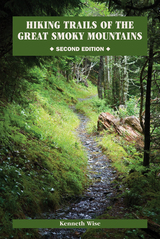
breathtaking and rugged national parks. The second edition of this compellingly readable
and useful book is completely updated, giving outdoor enthusiasts the most current
information they need to explore this world-renowned wilderness.
Included here are facts on more than 125 official trails recognized by the Park Service.
Each one has its own setting, purpose, style, and theme, and author Kenneth Wise
describes them in rich and vivid detail. For every route, he includes a set of driving directions
to the trailhead, major points of interest, a schedule of distances to each one, a
comprehensive outline of the trail’s course, specifics about where it begins and ends, references
to the U.S. Geological Survey’s quadrangle maps, and, when available, historical
anecdotes relating to the trail. His colorful descriptions of the area’s awe-inspiring beauty
are sure to captivate even armchair travelers.
Organized by sections that roughly correspond to the seventeen major watersheds
in the Smokies, Wise starts in Tennessee and moves south into North Carolina, with
two major trails—the Lakeshore and the Appalachian—that traverse several watersheds
treated independently. Further enhancing the utility of this volume is the inclusion of the
Great Smoky Mountains’ official trail map as well as an informative introduction filled
with details about the geology, climate, vegetation, wildlife, human history, and environmental
concerns of the region.
A seasoned outdoorsman with more than thirty years of experience in the area and
codirector of the Great Smoky Mountains Regional Project at the University of Tennessee,
Knoxville, Wise brings an exceptional depth of knowledge to this guide. Both experienced
hikers and novices will find this newly revised edition an invaluable resource for trekking in
the splendor of the Smokies.

The hippies of the late 1960s were cultural dissenters who, among other things, advocated drastic rethinking of certain traditional American values and standards. In this lucid, lively survey, Timothy Miller traces the movement's ethical innovations and analyzes the impact of its ideas on subsequent American culture.
Dedicated to such tenets as the primacy of love, trust in intuition and direct experience, the rejection of meaningless work, and a disdain for money and materialism, the hippies advocated dropping out of the dominant culture, and proposed new and more permissive ethics in several areas. They argued that, while some drugs were indeed harmful, others provided useful insights and experiences and therefore should be freely available and widely used. They endorsed a liberal ethics of sex, in which no sexual act between or among consenting adults would be banned. They developed an ethics of rock-and-roll music, arguing that rock was the language of a generation and that it helped promote new ways of thinking and living. They also revived the venerable American tradition of communal living.
In contrast to most available literature on the 1960s, this book deals with the cultural revolutionaries and not the political radicals of the New Left. And instead of relying on later interviews with persons who were active in the 1960s, Miller draws mainly on underground newspapers of the day, the most important literary creation of the hippies themselves. The result is a historical encounter of rare immediacy.
Timothy Miller is assistant professor of religious studies at the University of Kansas.
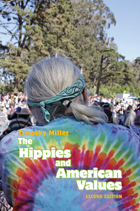
“Turn on, tune in, drop out,” Timothy Leary advised young people in the 1960s. And many did, creating a counterculture built on drugs, rock music, sexual liberation, and communal living. The hippies preached free love, promoted flower power, and cautioned against trusting anyone over thirty. Eschewing money, materialism, and politics, they repudiated the mainstream values of the times. Along the way, these counterculturists created a lasting legacy and inspired long-lasting social changes.
The Hippies and American Values uses an innovative approach to exploring the tenets of the counterculture movement. Rather than relying on interviews conducted years after the fact, Timothy Miller uses “underground” newspapers published at the time to provide a full and in-depth exploration. This reliance on primary sources brings an immediacy and vibrancy rarely seen in other studies of the period.
Miller focuses primarily on the cultural revolutionaries rather than on the political radicals of the New Left. It examines the hippies’ ethics of dope, sex, rock, community, and cultural opposition and surveys their effects on current American values. Filled with illustrations from alternative publications, along with posters, cartoons, and photographs, The Hippies and American Values provides a graphic look at America in the 1960s.
This second edition features a new introduction and a thoroughly updated, well-documented text. Highly readable and engaging, this volume brings deep insight to the counterculture movement and the ways it changed America. The first edition became a widely used course-adoption favorite, and scholars and students of the 1960s will welcome the second edition of this thought-provoking book.
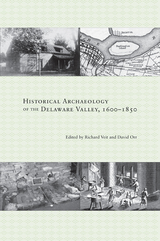
In Historical Archaeology of the Delaware Valley, 1600–1850, Richard Veit and David Orr bring together fifteen essays that represent the wide range of cultures, experiences, and industries that make this region distinctly American in its diversity. From historic-period American Indians living in a rapidly changing world to an archaeological portrait of Benjamin Franklin, from an eighteenth-century shipwreck to the archaeology of Quakerism, this volume highlights the vast array of research being conducted throughout the region. Many of these sites discussed are the locations of ongoing excavations, and archaeologists and historians alike continue to debate the region’s multifaceted identity.
The archaeological stories found within Historical Archeology of the Delaware Valley, 1600–1850 reflect the amalgamated heritage that many American regions experienced, though the Delaware Valley certainly exemplifies a richer experience than most: it even boasts the palatial home of a king (Joseph Bonaparte, elder brother of Napoleon and former King of Naples and Spain). This work, thoroughly based on careful archaeological examination, tells the stories of earlier generations in the Delaware Valley and makes the case that New England and the Chesapeake are not the only cultural centers of colonial America.
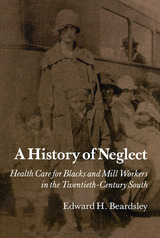
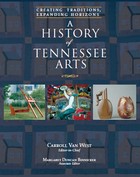
The harmonies of the Fisk Jubilee Singers, the measured brush strokes of painter Lloyd Branson, the intricate basket weaving of Maggie Murphy, the influence of the Agrarian literary movement, and the theater barnstorming of actor-manager Sol Smith—such are the sounds, images, and expressions of Tennessee’s arts legacy.
Through its interlocking themes of tradition and innovation, A History of Tennessee Arts: Creating Traditions, Expanding Horizons traces the story of the arts in Tennessee from its formal, more academic side to its vernacular expressions of culture, self, and community. Both the formal and the vernacular contribute to an understanding of what the arts mean to Tennesseans and, in turn, what Tennesseans have to offer the culture of the state, the region, and the nation. A history of the arts in the Volunteer State becomes, then, an evolving barometer of not only where we have been as a culture, but also how we have matured as a society.
This richly illustrated book, cosponsored by the Tennessee Arts Commission and the Tennessee Historical Society, covers the varieties of art in Tennessee in five parts. The visual arts and architecture section includes chapters on vernacular and high style architecture, sculpture, painting and photography, while the section on craft arts celebrates folk arts such as woodcraft, silversmithing, pottery, and textiles. The section on Tennessee’s rich literary history includes such writers as James Agee, Robert Penn Warren, and Evelyn Scott, while the performing arts are represented by a wealth of storytellers along with two centuries of stage history. Finally, Tennessee is home to—and originator of—much of the music that we know as distinctively American. Contributors to the music section examine gospel, blues, rock, soul, and, of course, country music.
From prehistoric cave paintings to the “cow punk” of Jason and the Scorchers, from the elegant capitol building of William Strickland to Ballet Memphis, and from the unique cantilevered barns of East Tennessee to the chronicles of Alex Haley, the arts in Tennessee truly celebrate traditions and strive to expand our horizons.
The Editor: Carroll Van West is director of the Center for Historic Preservation at Middle Tennessee State University and senior editor of the Tennessee Historical Quarterly.
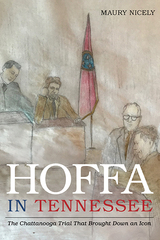
By the early 1960s, Jimmy Hoffa had a stranglehold on the presidency of the Teamsters Union. However, his nemesis, Attorney General Robert F. Kennedy, was convinced that Hoffa was a corrupt force whose heavy-handed influence over the union threatened the nation. As Attorney General, Kennedy established a “Get Hoffa Squad” that set out to unearth criminal wrongdoing by the labor leader in order to remove him from power. A number of criminal trials in the 1950s and early 1960s resulted in not-guilty verdicts for Hoffa. Matters would finally come to head in Chattanooga, Tennessee, in a climatic, but often overlooked, historical moment chronicled by Maury Nicely in this engrossing book.
After a Christmastime 1962 acquittal in Nashville of charges that Hoffa had illegally received funds from a trucking company in exchange for settling a costly strike, it was discovered that several attempts had been made to bribe jurors. Fresh charges of jury tampering in that case were quickly filed against Hoffa and five others. Moved to Chattanooga, the new trial was held before a young, relatively untested federal judge named Frank Wilson. The six-week courtroom conflict would devolve into a virtual slugfest in which the defense team felt was necessary to turn its ire against Wilson, hoping to provoke an error and cause a mistrial. As Nicely shows in vivid detail, Hoffa’s Chattanooga trial became the story of a lone, embattled judge struggling mightily to control a legal proceeding that teetered on the edge of bedlam, threatening to spin out of control. In the end, Hoffa was convicted-an extraordinary change of fortune that presaged his downfall and mysterious disappearance a decade later.
In examining how justice prevailed in the face of a battering assault on the judicial system, Hoffa in Tennessee demonstrates how a Chattanooga courtroom became a crucial tipping point in Jimmy Hoffa’s career, the beginning of the end for a man long perceived as indomitable.
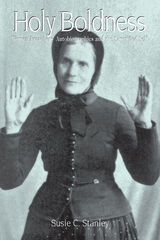
From its inception in the nineteenth century, the Wesleyan/Holiness religious tradition has offered an alternative construction of gender and supported the equality of the sexes. In Holy Boldness, Susie C. Stanley provides a comprehensive analysis of spiritual autobiographies by thirty-four American Wesleyan/Holiness women preachers, published between the mid-nineteenth and mid-twentieth centuries. While a few of these women, primarily African Americans, have been added to the canon of American women’s autobiography, Stanley argues for the expansion of the canon to incorporate the majority of the women in her study. She reveals how these empowered women carried out public ministries on behalf of evangelism and social justice.
The defining doctrine of the Wesleyan/Holiness tradition is the belief in sanctification, or experiencing a state of holiness. Stanley's analysis illuminates how the concept of the sanctified self inspired women to break out of the narrow confines of the traditional “women's sphere” and engage in public ministries, from preaching at camp meetings and revivals to ministering in prisons and tenements. Moreover, as a result of the Wesleyan/Holiness emphasis on experience as a valid source of theology, many women preachers turned to autobiography as a way to share their spiritual quest and religiously motivated activities with others.
In such writings, these preachers focused on the events that shaped their spiritual growth and their calling to ministry, often giving only the barest details of their personal lives. Thus, Holy Boldness is not a collective biography of these women but rather an exploration of how sanctification influenced their evangelistic and social ministries. Using the tools of feminist theory and autobiographical analysis in addition to historical and theological interpretation, Stanley traces a trajectory of Christian women’s autobiographies and introduces many previously unknown spiritual autobiographies that will expand our understanding of Christian spirituality in nineteenth- and twentieth-century America.
The Author: Susie C. Stanley is professor of historical theology at Messiah College. She is the author of Feminist Pillar of Fire: The Life of Alma White.
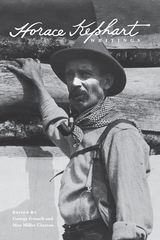
Best known for Our Southern Highlanders (1913) and Camping and Woodcraft (1916), Horace Kephart’s keen interest in exploring and documenting the great outdoors would lead him not only to settle in Bryson City, North Carolina, but also to become the most significant writer about the Great Smoky Mountains in the early twentieth century.
Edited by Mae Miller Claxton and George Frizzell, Horace Kephart: Writings extends past Kephart’s two well-read works of the early 1900s and dives into his correspondence with friends across the globe, articles and columns in national magazines, unpublished manuscripts, journal entries, and fiction in order to shed some deserved light on Kephart’s classic image as a storyteller and practical guide to the Smokies. The book is divided into thematic subsections that call attention to the variety in Kephart’s writings, its nine chapters featuring Kephart’s works on camping and woodcraft, guns, southern Appalachian culture, fiction, the Cherokee, scouting, and the park and Appalachian trail. Each chapter is accompanied by an introductory essay by a notable Appalachian scholar providing context and background to the included works.
Written for scholars interested in Appalachian culture and history, followers of the modern outdoor movement, students enamored of the Great Smoky Mountains, and general readers alike, Horace Kephart: Writings gathers a plethora of little-known and rarely seen material that illustrates the diversity and richness found in Kephart’s work.
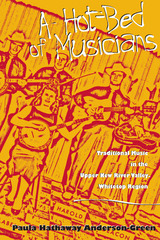
In A Hot-Bed of Musicians, Paula Anderson-Green tells the stories of several of these legendary performers and instrument makers from the Upper New River Valley–Whitetop Mountain region, including Ola Belle Campbell Reed, Albert Hash, and Dave Sturgill. These men and women began to bring the music of Appalachia to a wider audience well before Nashville became the center of country music. Making extensive use of interviews, the book reveals the fascinating experiences and enduring values behind the practice of old-time music. This musical heritage remains an indispensable component of Appalachian culture, and Anderson-Green traces the traditions down to the present generation of musicians there.
Written for anyone with an interest in mountain music, this book focuses on performers from Alleghany and Ashe Counties in North Carolina and Carroll County and Grayson County in Virginia. It includes a comprehensive appendix of place names and music venues as well as annotated lists of musicians and the songs they have performed.
The Author: Paula Hathaway Anderson-Green is an adjunct professor of English at Kennesaw State University and does research in Appalachian studies.
READERS
Browse our collection.
PUBLISHERS
See BiblioVault's publisher services.
STUDENT SERVICES
Files for college accessibility offices.
UChicago Accessibility Resources
home | accessibility | search | about | contact us
BiblioVault ® 2001 - 2024
The University of Chicago Press









